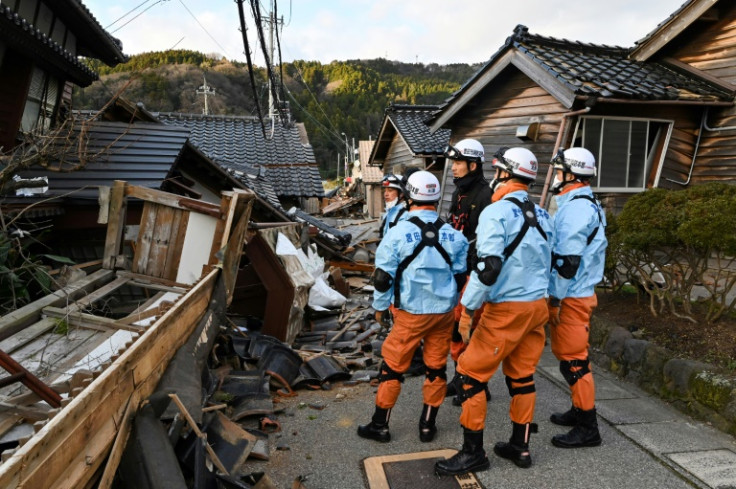Sighting Of 'Doomsday Fish' Linked To Earthquake In Japan
It is said that the oarfish run to the surface when there is a possibility of an earthquake or tsunami.

In July last year, divers in Taiwan spotted an oarfish, a rare deep-sea creature also referred to as the "harbinger of death" or the "doomsday fish".
The sighting has now been linked to the earthquake in Japan that has claimed over 60 lives so far. The 7.5-magnitude quake on January 1 that hit Ishikawa Prefecture also triggered tsunami waves on the western coast. It is being described as one of the biggest disasters to hit Japan since 2011.
In Japanese mythology, the oarfish are seen as harbingers of earthquakes and catastrophic events. But it has not been scientifically proven.
"Whatever the oceanographic phenomena are that push these animals on shore, they're probably on a large enough scale to affect more than one oarfish," Mark Benfield, an oceanographer at Louisiana State University, told National Geographic.
The fish resembles a sea serpent and has also been nicknamed "The Messenger from the Sea God's Palace".
It is said that the oarfish run to the surface when there is a possibility of an earthquake or tsunami. At least a dozen oarfish had washed ashore in Japan months before the deadly 2011 earthquake.
The latest earthquakes have given fodder to conspiracy theorists and people who believe in these myths. Several of them took to social media in the aftermath of the New Year's Day earthquake to highlight how the oarfish was sighted off Taiwan's coast months ago before the latest catastrophe hit Japan.
Off Taiwan’s coast, divers found a “Doomsday fish” — a giant Herring king associated with earthquake predictions. Its size and shape resembling a sea serpent, locals consider it an ominous sign in Japanese mythology 😳 pic.twitter.com/GD938yg1OJ
— ꧁༺𝐕𝐢𝐤𝐭𝐨𝐫𝐢𝐚𝐧𝐚༺꧂ ☃️ (@8102ops) January 2, 2024
"The legend is that if you see an oarfish (DOOMSDAY FISH), it is a warning sign from higher powers that disasters such as earthquakes are soon to occur," tweeted an X user.
The oarfish can grow more than 30 feet in length and weigh up to 600 pounds. According to the Guinness Book of World Records, it is the longest bony fish known to exist currently.
Meanwhile, the death toll in Japan has climbed to 62, even as the rescuers work around the clock to search for survivors. More than 300 people have sustained injuries and at least 31,800 people are living in shelters, per the data provided by the Japanese authorities.
The legend is that if you see an oarfish(DOOMSDAY FISH), it is a warning sign from higher powers that disasters such as earthquakes are soon to occur. According to numerous news reports, before Japan's 2011 earthquake (one of the most catastrophic in history) a total of 20… pic.twitter.com/FVBPHWbE99
— WarMonitoreu (@WarMonitoreu) January 1, 2024
"More than 40 hours have passed since the disaster. We have received a lot of information about people in need of rescue, and there are people waiting for help," said Prime Minister Fumio Kishida.
"Rescue efforts are being made by the local authorities, police, firefighters and other operational units, while the number of personnel and rescue dogs is enhanced".
The death toll is expected to rise as rescuers battle aftershocks and poor weather. Thousands of households have been left without water and electricity in the worst-affected areas of the Noto Peninsula in Ishikawa prefecture.
The big picture:
According to the Japanese government, the number of earthquakes on the peninsula has been increasing steadily since 2018. More than 400 earthquakes have been reported in the region since Monday.
The authorities have warned of more such tremors in the coming days. Japan is hit by quakes regularly as it sits on top of three tectonic plates: North America, the Pacific, and the Philippine Sea. It experiences around 20% of the world's most powerful earthquakes every year.
Devastating earthquakes have struck Japan in the past, claiming tens of thousands of lives. The magnitude 9.0 March 2011 earthquake that hit the Tohoku region triggered a tsunami that killed more than 18,500 people.
Japan lies on the Pacific "Ring of Fire" and has more than 100 active volcanoes. It is a horseshoe-shaped belt of fault lines and volcanoes that runs for some 40,000 kilometres. Many of the volcanoes in Japan are monitored 24/7 by its meteorological agency.
The seismically active Ring of Fire covers the South Pacific islands, up through Indonesia and Japan, across to Alaska, and down the west coast of the United States and Central and South America.
© Copyright IBTimes 2025. All rights reserved.





















